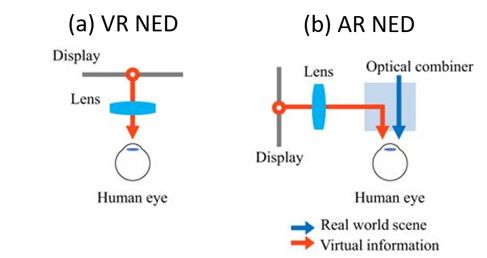

Hotline:0755-22277778
Tel:0755-22277778
Mobile:13826586185(Mr.Duan)
Fax:0755-22277776
E-mail:duanlian@xianjinyuan.cn
Optical waveguide is considered a must-have optical solution for consumer grade AR glasses due to its lightweight and high penetration characteristics of external light, but its high price and technical threshold make people hesitate.
So, what is the working principle of optical waveguide? What are the differences between the various array waveguides, geometric waveguides, diffractive waveguides, holographic waveguides, and multilayer waveguides available on the market? How has it gradually changed the market landscape of AR glasses? Which optical waveguide technology do we prefer and why?
Next, let Rokid R-lab optical research scientist and Dr. Li Kun from the Department of Electronic Engineering at the University of California, Berkeley, tell you in detail.
Augmented reality (AR) and virtual reality (VR) are widely studied technological fields in recent years. Their near eye display systems both use a series of optical imaging elements to form a distant virtual image of pixels on the display and project it into the human eye.
The difference is that AR glasses require see through, seeing both the real external world and virtual information, so the imaging system cannot block the line of sight. This requires the addition of one or a set of optical combiners, which can be stacked together to integrate virtual information with the real scene, complementing and enhancing each other.

Figure 1 (a) Schematic diagram of a virtual reality (VR) near eye display system; (b) A schematic diagram of an augmented reality (AR) near eye display system. NED: Near eye display (NED)
The optical display system of AR devices typically consists of a miniature display screen and optical components. In summary, the display systems currently used in AR glasses on the market include various micro displays and prisms, free-form surfaces BirdBath、 The combination of optical components such as waveguides, among which the optical combiner is different, is a key part to distinguish AR display systems.
Micro display screens are used to provide display content for devices. It can be self luminous active devices, such as light-emitting diode panels like micro OLED and the now popular micro LED, or liquid crystal displays that require external light source illumination (including transmissive LCD and reflective LCOS), as well as digital micro mirror arrays (DMD, the core of DLP) and laser beam scanners (LBS) based on microelectromechanical systems (MEMS) technology.
Here is a simple classification and product example of AR optical display systems:

It is obvious that a perfect optical solution has not yet emerged, which is why there are currently a hundred schools of thought and a hundred flowers blooming in the market. This requires AR glasses product designers to make trade-offs based on application scenarios, product positioning, and other factors.
We believe that the optical waveguide scheme has the best development potential in terms of optical effects, appearance, and mass production prospects, and may be the best choice to bring AR glasses to the consumer level.
In the above-mentioned optical imaging elements,Optical waveguide shielding materialTechnology is a unique optical component designed to meet the needs of AR glasses. It is considered a must-have optical solution for consumer grade AR glasses due to its lightweight and high penetration of external light. With the adoption and mass production of optical waveguides in devices such as Microsoft Hololens and Magic Leap One, the discussion on optical waveguides continues to increase.
In fact, waveguide technology is not a new invention. In the familiar optical communication system, the optical fibers used to transmit signals form countless submarine cables connecting the other side of the ocean, which is a type of waveguide. However, it transmits light in the infrared band that we cannot see.
In AR glasses, in order for light to transmit without loss or leakage, "total reflection" is the key, which means that light travels back and forth in the waveguide like a swimming snake without being transmitted.
Simply put, achieving total reflection requires two conditions to be met:
(1) The transmission medium, i.e. waveguide material, needs to have a higher refractive index than the surrounding medium (as shown in Figure 2, n1>n2);
(2) The incident angle of light entering the waveguide needs to be greater than the critical angle θ c.

Advanced Institute (Shenzhen) Technology Co., Ltd, © two thousand and twenty-onewww.avanzado.cn. All rights reservedGuangdong ICP No. 2021051947-1 © two thousand and twenty-onewww.xianjinyuan.cn. All rights reservedGuangdong ICP No. 2021051947-2